
St Asaph Cathedral, the smallest medieval cathedral in Britain
ST ASAPH CATHEDRAL is THE SMALLEST MEDIEVAL CATHEDRAL IN BRITAIN. A church was built here by St Kentigern, Bishop of Strathclyde, also known as St Mungo, in AD 560. When St Kentigern returned to Scotland in AD 573, he left his student, Asaph, in his place as Bishop.
The present cathedral building dates mainly from the 13th and 14th centuries. Buried inside, close to the Bishop’s throne, is WILLIAM MORGAN, BISHOP OF ASAPH (1545–1604), whose translation of the Bible into Welsh (see Caernarfonshire) is considered to be the most important single contribution to the preservation of the Welsh language. The cathedral possesses to this day a 1588 first edition of Morgan’s Welsh Bible, which was used at Prince Charles’s investiture as Prince of Wales at Caernarfon Castle in 1969.
There is a memorial in the cathedral to the poetess FELICIA HEMANS (1793–1835), who lived most of her life in and around St Asaph. Her best-known poem was called ‘Casablanca’ and starts with the line ‘The boy stood on the burning deck …’
As the seat of an ancient cathedral, St Asaph was historically considered a city, but is not recognised as such today. The widespread belief that having a cathedral or a university automatically confers city status is mistaken. Brecon and St Asaph are the only two Welsh cathedral towns denied city status, despite St Asaph having applied twice in recent years. (The other four Welsh cathedral cities are Bangor, St David’s, Cardiff (Llandaff) and Newport, Monmouthshire.)
Former Liverpool and Wales footballer IAN RUSH was born in St Asaph in 1961. He is WALES’S RECORD GOAL-SCORER with 28 goals in 73 appearances.
LISA SCOTT-LEE, former member of the band Steps, was born in St Asaph in 1975.
SOME 1300 YEARS ago, in the 7th century, a gentle young girl of noble birth called Winefride was studying alone at home, when the evil Prince Caradog forced his way in and attempted to ravish her. She managed to escape and fled towards her uncle St Bueno’s church on the hill, but Caradog caught up with her and, maddened with rage and lust, sliced her head off with his sword. St Bueno and Winefride’s brother Owain returned at that moment, and Owain slew Caradog where he stood. St Bueno picked up Winefride’s head and replaced it on her shoulders, praying as he did so. She was miraculously restored to life, and she and St Bueno sat down on the stone that today bears his name.

At the spot where her head had fallen, a spring gushed forth, and St Bueno told Winefride that anyone who drank from the spring and prayed for her help would find succour. Winefride went on to become an Abbess at Gwytherin Convent near Llanrwst, and her well at Holywell has been a place of pilgrimage ever since. She is buried in Shrewsbury Abbey.
Although the holy well of ST WINEFRIDE has been recorded as a place of pilgrimage since the 11th century, and Henry V came here in 1416 after the Battle of Agincourt, it is one of the unknown places of Wales. It is about a quarter of a mile (0.4 km) outside the little industrial market town of Holywell, with its wide main street, just far enough removed from the bustle and the A55 to remain a real sanctuary of peace and tranquillity. Possibly because it is so easy to overlook, St Winefride’s Well is THE ONLY SHRINE IN WALES TO HAVE SURVIVED IN CONTINUOUS USE FROM ITS FOUNDATION TO THE PRESENT DAY.
A beautifully vaulted crypt has been built around the well, with access from the north through a graceful triple arcade. A rather worn pendant boss, carved with the tale of St Winefride, hangs over the spring, while built directly above the crypt is a divine little pilgrim’s chapel. All of this is the work of Margaret Beaufort, mother of Henry VII, and was constructed in 1490. This is one of the most special places in all of Wales, and for most of the time is blissfully uncrowded.
St Winefride’s Well is one of the traditional Seven Wonders of Wales mentioned in the famous 19th-century rhyme.
The poet GERALD MANLEY HOPKINS (1844–89) loved St Winefride’s Well, and was inspired by the beauty of the area to write what is regarded as his finest poetry. He first came here in 1874 while studying at the Jesuit college of St Bueno, nearby at Tremeirchion.
Actor JONATHAN PRYCE was born in Holywell in 1947.
FLINT WAS ONCE the port for Chester and has THE OLDEST TOWN CHARTER IN WALES, dating from 1284.
The ruins of Flint Castle, the first of Edward I’s iron ring of fortresses, stand on a rocky platform above the marshes of the Dee estuary. Flint is THE ONLY CASTLE IN BRITAIN TO HAVE A SEPARATE DONJON, or Great Tower, detached from the rest of the castle, and used to be surrounded by a moat, filled from the Dee. The walls of the donjon, which was built in 1277–80, are 23 ft (7 m) thick, THE THICKEST CASTLE WALLS IN THE WORLD. In 1399, Richard II was made captive here and forced to surrender to Henry Boling-broke, later Henry IV. The scene was re-enacted in Act III, Scene iii of William Shakespeare’s Richard II.

King Edward I’s iron ring of fortresses were the most ambitious building project of medieval Europe, and were designed to contain and subdue once and for all the heartlands of the Welsh Princes of Gwynedd, Anglesey and Snowdonia. The major castles of the iron ring are Flint, Rhuddlan, Conwy, Harlech, Caernarfon and Beaumaris. They were all the work of the foremost architect of the day, James of St George, and are considered to be the most advanced and sophisticated strongholds of their time anywhere in the world.
Film star TOM CRUISE’S great-great-grandfather emigrated to America from Flint in 1850.
IN ST DEINIOL’S church in HAWARDEN there is a gorgeous stained-glass window by Sir Edward Burne-Jones, honouring the only man to be Prime Minister four times, WILLIAM GLAD-STONE (1809–98). The window was unveiled in 1898, the year that Glad-stone died, and was BURNE-JONES’S LAST WORK, for he passed away later that same year.
Nearly 60 years earlier William Glad-stone came to Hawarden to marry Catherine Glynne, heiress to Hawarden Castle. Hawarden became his ‘Temple of Peace’, away from the hurly-burly of Westminster politics. His greatest relaxation was felling the trees on the estate, and that is precisely what he was doing when summoned for the first time by Queen Victoria to form a government. He later opened the grounds to the public, and they flocked to see him at work with his axe.
Felling trees was not without its hazards. On one occasion, he was almost blinded in one eye by a splinter that flew up from the tree he was chopping at. Many years later, in 1892, his other eye was equally badly damaged when he was hit in the face by a ginger biscuit, thrown by a woman at his open carriage as he was driving to make a speech in Chester. On another occasion, he was walking through the park with Catherine when they were charged at by a wild heifer. Gladstone threw himself in front of his wife to protect her and was sent sprawling in the dirt. The heifer was later caught and shot, and its head displayed in the village pub.
The park also contains the ruins of the original 13th-century Hawarden Castle, an impressive stone motte and bailey fort, sitting amongst trees not far from the present, romantically castellated Hawarden Castle, which dates from 1752.
Next to St Deiniol’s church stands the St Deiniol Library, based on Gladstone’s personal library of over 30,000 books. It is probably the greatest collection of books about the Victorian era that exists outside the British Library.
The huge bronze statue of Gladstone in the village was intended for Dublin, but was rejected by the city following Irish independence – ironically, Irish Home Rule being the one great aspiration of Gladstone’s that he never managed to achieve in his lifetime.
MOLD IS A busy, bustling market town gathered around the foot of the Mont Haut or ‘high mound’ that gives the town its name. Its Welsh name Yr Wyddgrug also means high mound, and refers to the motte that survives on Bailey Hill at the top of the High Street.
At the foot of Bailey Hill, casting its benevolent gaze over the town, is Mold’s pride and joy, the beautiful church of St Mary’s, founded by Margaret Beaufort to commemorate her son Henry VII’s victory at Bosworth Field in 1485. The impressive tower was added in 1773.

Mold has a rich artistic heritage that goes back a long way. In 1833, workmen quarrying for stone at Bryn yr Ellyllon, or Goblin’s Hill, to the north of the town, uncovered a Bronze Age burial mound. Inside was a skeleton, some amber beads and THE LARGEST GOLD OBJECT EVER FOUND IN WALES, a unique cape, weighing 1¼ lbs (560 g) and produced from a single gold ingot. The MOLD GOLD CAPE, as it became known, is around 4,000 years old, of high-quality gold, gloriously decorated, and thought to be a ceremonial or religious garment. Discovery of the cape went some way towards explaining the well-documented stories of hauntings in the area, with a number of people over the years reporting sightings of a gigantic man standing on Goblin’s Hill, ‘glittering and shining in gold’.
The cape was sold to the British Museum and is regarded as one of the Museum’s top 10 exhibits. Many local people feel it should be returned to the town where it was found.
Outside in the churchyard of St Mary’s, close to the north wall of the church, is the simple stone tomb of RICHARD WILSON (1714–82), Wales’s greatest artist and THE FATHER OF BRITISH LANDSCAPE PAINTING. He was born at Penegoes, near Machynlleth, where his father was the Vicar, but spent most of his childhood in Mold, having moved there after his father died.
He showed prodigious talent as an artist from an early age and went to London in 1729 to become a portrait painter. His subjects included Bonnie Prince Charlie’s Flora Macdonald and the young royal princes. His real passion, though, was for landscapes, and he spent six years in Italy studying and developing his own natural style. On his return, under the auspices of his two patrons Sir Watkin Williams-Wynn and the 1st Lord Lyttelton, Wilson began to paint the wild mountains and dramatic landscapes of his Welsh homeland and so build his reputation. Particularly admired are his paintings of Mt Snowdon, Cader Idris, and Caernarfon and Cilgerran castles. He was one of the founders of the Royal Academy in 1768, becoming the Academy Librarian in 1776.
Richard Wilson was the first British artist to concentrate on landscapes. At the time, however, these were considered inferior to portraits and so commissions were scarce. In 1781, sick and impoverished, he retired to his cousin’s house, Colomendy Hall, near Mold, where he died a year later.
Richard Wilson was not much honoured in his lifetime, but his powerful and romantic pictures inspired people to come and see Wales for themselves. As a result, a land that had previously been seen as barbaric and fearsome suddenly won appreciation for its beauty, and it was explored by artists such as J.M.W. Turner and John Constable, who willingly acknowledged his influence on them. Today his pictures are highly prized and grace some of the world’s greatest art collections.
Outside the town library there is a bronze statue of DANIEL OWEN (1836–95), generally acknowledged as WALES’S GREATEST NOVELIST. The statue is adorned with his own words which, translated from the Welsh, read, ‘I wrote, not for the wise and learned, but for the common man.’ Owen was born in Mold and spent most of his life there. He wrote only in Welsh and is sometimes referred to as ‘the Welsh Dickens’ for his vivid stories of real, everyday life. He is buried in Mold Municipal Cemetery.
About three miles outside Mold, beside the road to Ruthin, at the entrance to the Loggerheads Country Park, stands the ancient Three Loggerheads Inn. Richard Wilson, who lived nearby at Colomendy Hall, was a regular visitor and, in return for a couple of pints, he painted the inn sign, a replica of which swings in the wind outside the pub today. The original hangs on a wall inside, a unique and precious memento of the first great British landscape artist. The sign shows two men’s heads above the words ‘We Three Loggerheads’, the third person being the one looking on. The story behind the picture is of a local vicar and landowner who were in dispute, and were persuaded by the landlord of the Loggerheads to meet at the inn to try and resolve their long-running differences. Hence, the expression to be ‘at Loggerheads’ came to mean to be in disagreement with someone.

The area of craggy limestone hills to the west of Mold is said to have inspired FELIX MENDELSSOHN when writing his opus Rivulet.
A plaque on the former Assembly Hall, now a bank, commemorates a visit from THE BEATLES, who played there on 24 January 1963.
JONNY BUCKLAND, the lead guitarist of the band COLDPLAY, came with his family to live in Pantymwyn, 2 miles (3 km) from Mold, when he was four. Between the ages of 11 and 18 he attended Mold Alun school.
Wales, while famous for its castles, is not particularly noted for its ‘stately homes’ or domestic architecture. In fact, there are countless houses of great quality and interest hidden away behind walls and trees throughout the country, but they are rarely advertised. The area around Mold positively abounds in lovely houses. Below are two of the most fascinating examples in Flintshire.
THE TOWER, built around 1445 for Rheinallt ap Gruffydd ap Bleddyn, is an exquisite example of a Welsh tower-house. It is also a rarity – thereafter it was generally thought less necessary to fortify homes. In the early 18th century, the Tower was extended and remodelled to make it more comfortable to live in. The original defensive turret with its superb, pyramid-shaped stone roof was cleverly incorporated into the new house, and the whole effect is very satisfying. The Tower, which is near Nercwys, about 2 miles (3 km) south of Mold, stands in delightful gardens with a pond and can be visited by appointment.
PLAS TEG looms above the Flint countryside some 3 miles (5 km) south-east of Mold. It was built for Sir John Trevor, Surveyor of the Queen’s Ships, in 1610, THE EARLIEST JACOBEAN HOUSE IN WALES. It was an extraordinarily advanced house for its day, the grandest private home in Wales, an unmistakable expression of the prestige and power of the Trevor family. Plas Teg remained in the Trevor and, latterly, Trevor-Roper family until after the Second World War, when it started to fall into decline. After several rescue attempts the house was bought by a private owner Cornelia Bayley, in 1986 and is now restored to its full glory. It can be visited on Sundays or by appointment. Plas Teg has one other claim to fame. It is considered to be THE MOST HAUNTED HOUSE IN WALES.
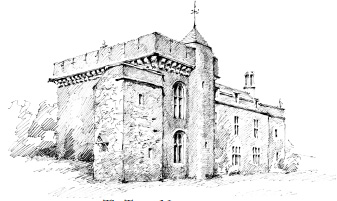
The Tower, Nerewys
BANGOR-IS-Y-COED, sometimes known as Bangor-on-Dee, a small village in the detached portion of Flintshire beyond Wrexham to the south-east, is the site of THE EARLIEST MONASTERY IN BRITAIN, founded in AD 180. One of the Abbots here, PELAGIUS, preached a doctrine that became known as the ‘Pelagian Heresy’, which maintained that every individual had the free will to accept or reject Salvation as they wished.
In AD 613, after the Battle of Chester, the 1200 monks of Bangor-is-y-coed were massacred by the Saxons from Northumbria, for refusing to give up their Celtic Christianity in favour of the doctrines of the Roman Catholic Church, as espoused by St Augustine. The few monks that survived fled to Bardsey Island, where they established a new monastery.
There is nothing left at all of the abbey, which was razed to the ground. The village is known today for its bridge, thought to be by Inigo Jones, and for the Bangor-on-Dee racecourse, one of only two racecourses in Wales, the other being at Chepstow.
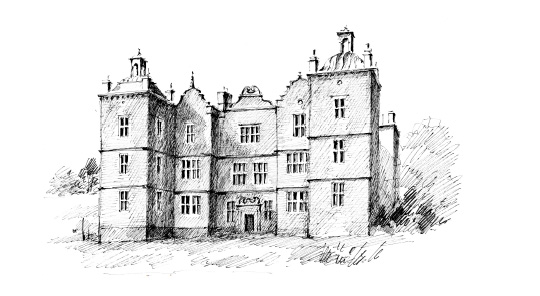
Plas Teg – the most haunted house in Wales?
ALTHOUGH A VICTORIAN seaside resort in North Wales like its neighbour Llandudno, RHYL is everything that Llandudno is not: brash, lively and un-restrained. The sandy beach stretches for miles, and every conceivable type of attraction is offered. There is BRITAIN’S OLDEST MINIATURE RAILWAY, opened in 1911, one of Britain’s first all-weather leisure attractions, the Sun Centre, with THE FIRST POOL IN EUROPE TO FEATURE INDOOR SURFING, and a 240 ft (73 m) high Sky Tower.
RUTH ELLIS, THE LAST WOMAN TO BE HANGED IN BRITAIN, in 1955, was born in Rhyl in 1927.
‘Liver Bird’ NERYS HUGHES was born in Rhyl in 1941.
The A6 murderer JAMES HANRATTY claimed to be staying in Rhyl, at a guesthouse in Kinmel Street, at the time of the murder in 1961. His alibi didn’t stand up, and he was found guilty and executed. There are some who still think him innocent.
Countdown presenter CAROL VORDER-MAN learned her passion for numbers from her maths teacher Mr Parry, while attending the Blessed Edward Jones school in Rhyl.
The 1973 film of On the Buses, starring Reg Varney, was shot in Rhyl.
Rhyl was the scene of the celebrated incident, during the 2001 General Election, when the Deputy Prime Minister, JOHN PRESCOTT, threw a punch at a member of the public who had hit him with an egg.

RHUDDLAN CASTLE WAS the first of the concentric castles James of St George built in Wales, a design which reached its apogee at Beaumaris (see Anglesey). It stands on a mound known as Twthill, 60 ft (18 m) above the River Clwyd, and in another extraordinary feat of engineering, the castle was made accessible from the sea, 3 miles (5 km) away, by canalising the final stretch of the river.
Edward I made Rhuddlan his headquarters during his Welsh campaigns, and in March 1284 he issued the Statute of Rhuddlan, uniting the Principality of Wales with England. The Statute, which lasted until the Act of Union in 1536, replaced the Welsh legal system with the English and created the new Welsh counties of Flintshire, Caernarfonshire, Merioneth, Cardiganshire and Carmarthenshire. There is a plaque commemorating the event on the wall of Parliament House, which stands where Edward proclaimed the Statute, and from where he promised to make his son ‘Prince of Wales’.
Flintshire is THE SMALLEST COUNTY IN WALES.
Flintshire boasts two of the ‘Seven Wonders of Wales’: St Winefride’s Well (see above) and the 21 yew trees that surround St Mary’s Church at OVERTON, a village in the detached portion of Flintshire south-east of Wrexham. In 1992 a new yew tree was planted by Queen Elizabeth II.
Standing beside the road in a field near the village of Whitford, north-west of Holywell, is MAEN ACHWYFAEN, the ‘Stone of Lamentation’, a sculptured Celtic wheel cross, dating from the early 10th century. It is THE TALLEST CROSS OF ITS KIND IN BRITAIN.
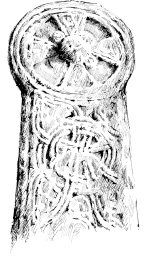
The village church of TREMEIRCHION, near St Asaph, is THE ONLY MEDIEVAL CHURCH IN BRITAIN DEDICATED TO CORPUS CHRISTI.
Nestling on the slopes of the northern Clwydian hills, between the two holy sites of St Asaph and Holywell, is Flintshire’s most dauntingly named village, SODOM.
BODELWYDDAN HALL, a mid-19th-century battlemented house set in 260 acres (105 ha) of parkland west of St Asaph, is now an outstation of the National Portrait Gallery, exhibiting a permanent collection of Victorian portraits and furniture. Nearby is the ebullient, unrestrained Marble Church of gleaming local white limestone, with a 200 ft (60 m) spire, commissioned by Lady Willoughby de Broke in 1860, in memory of her husband. Lying in the north-east corner of the churchyard is Elizabeth Jones, mother of Sir Henry Morton Stanley (see Denbighshire).
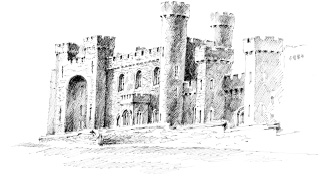
MOEL FAMAU, ‘the Mother of Mountains’, stands 1,820 ft (555 m) high, the highest point on the Clwydian range of hills. At the summit are the gaunt remains of the Jubilee Tower, built in 1810 to commemorate the Golden Jubilee of George III in 1809. It consisted of a tall pillar standing on a vast square base and was celebrated as THE FIRST MONUMENT IN BRITAIN TO BE BUILT IN THE EGYPTIAN STYLE. The pillar was blown down by a storm in 1852, and nowadays just the dilapidated base remains.
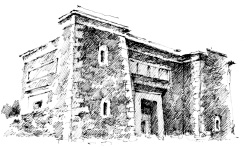
BODRHYDDAN HALL, just west of Dyserth, is a picturesque 17th-century house belonging to the Conwy family. The Charter of Rhuddlan is held here, and in the Drawing Room there are wooden panels from the chapel of a Spanish Armada ship, wrecked off the coast of Anglesey.
PRESTATYN stands at the northern end of Offa’s Dyke.
MIKE PETERS, front man of the biggest Welsh band of the 1980s, THE ALARM, was born in Prestatyn in 1959. The Alarm played their first gig at the Victoria Hotel in Prestatyn on 10 June 1981.
Britain’s first major offshore wind farm, the NORTH HOYLE OFFSHORE WIND FARM, was opened 4 miles (7 km) off the coast of Prestatyn in 2003. Thirty turbines with a combined maximum capacity of 60 megawatts generate enough energy to power 40,000 homes.
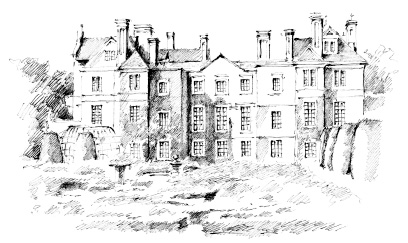
Bodrhyddan Hall